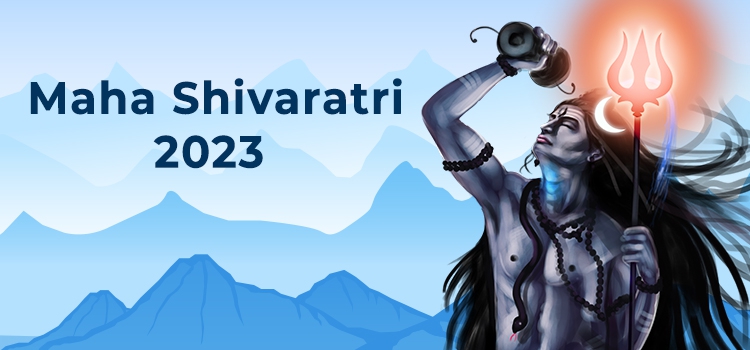Maha Shivaratri 2023
Every year, Shiva devotees eagerly look forward to ‘the great night of Shiva’ or Maha Shivaratri to connect with their favorite deity. It is the most important among the 12 Shivaratris in a year. Every month, on the 14th day, people celebrate Shivaratri. It is the day before the new moon. Maha Shivaratri is usually celebrated on the 4th day of Krishna Paksha (waning fortnight) in the month of Magha (February – March). Maha Sivaratri 2023 is on February 18.
The festival commemorates the marriage of Shiva and Parvati. It is also believed that on this night, Shiva danced the Tandava. But ascetics believe that Shiva became the Adi Yogi, the first Guru of the yogis, on this day. Thus, people celebrate this day for varied reasons.

Married people worship Shiva on this day seeking relief from their marital problems. Unmarried girls observe fast and pray to him, seeking a good husband. The more spiritually inclined worship him so that their sins and mistakes in current and previous births will be erased. Others invoke his blessings for wealth, success, good health, and abundance.
Maha Shivaratri Pooja Vidhi
- Rise early in the morning and take a bath.
- Wear clean clothes.
- Take a vow (sankalp) and pray that you can complete the fast successfully.
- Sit in a calm place and do meditation.
- Place Shiva’s idol or Shiva Linga on a wooden platform. Then use a fresh white cloth to cover it.
- Light an oil lamp and place it to the left of the platform.
- Sprinkle some drops of water on the feet of the idol/Linga and begin the Pooja.
- Offer arghya to the idol/Linga.
- Perform achamana (pour water in your right palm and drink it).
- Do Abishek for the idol/Linga with Ganga Jal, milk, curd, and honey.
- Cover the idol/Linga with clean white clothes.
- Offer a sacred thread/kalava to the idol/Linga.
- Offer some akshat and a janeu to the idol/Linga.
- Smear some perfume and chandan paste on the idol/Linga.
- Offer bel leaves, flowers of giant milkweed and datura, fruits, etc., to the idol/ Linga.
- Light dhoop or incense sticks.
- Offer Naivedya or Bhog.
- Perform Parikrama.
- Perform Aarti after offering prayers to Shiva, and then offer Pushpanjali.
- Do parana according to parana muhurat.
Some Maha Sivaratri Rituals
- People of all ages observe a fast on this day. It is usually a total fast.
- Many devotees visit the Kashi Vishwanath temple and perform Milk Abisheka and Jal or water Abisheka.
- Many take a dip in the Ganga to purify their minds, bodies, and souls.
- Shiva symbolizes hygiene, knowledge, and penance. Devotees put 3 horizontal lines on their foreheads to mark this.
- People make offerings to the Rudraksha tree, as they believe that it was born of Shiva’s tears.
Maha Shivaratri’s Astrological Importance
Shivaratri is on the 14th day of Krishna Paksha Chaturdashi (dark lunar fortnight). Shiva rules Chaturdashi Tithi. Astrology says that the Moon has a great influence on our mind. But on Maha Shivaratri, the Moon’s influence is weak. By worshipping Shiva, who wears the Moon on his forehead, we can boost the Moon’s influence in our birth chart, thereby increasing our mental strength, willpower, courage, and endurance.
Maha Shivaratri in Different Regions of India
Tamil Nadu
In Tamil Nadu, devotees worship their ‘kula deivam’ or family deity and spend the whole night at the temple chanting Mantras and reading hymns and songs dedicated to Shiva, like Thiruchitrambala, Shiva Purana, etc. All Shiva temples are jampacked with devotees who fast without food throughout the day and night. They also perform Rudrabhishek, Anna Abishek, Vibhuthi Abishek, and more to the Shiva Lingam. Vilva leaves are offered, and they chant the Mantra "Om Namah Shivaya" throughout the night.
Karnataka
Here, Sri Shidingappa’s Mela takes place on this day. Devotees carry the idol of the deity in a palanquin to the river.
West Bengal
Devotees use sand to make 4 Shiva lingas and do Abishek using milk, curd, ghee, and honey.
Madhya Pradesh
Devotees take a bath in the Shiva Sagar tank (Khajuraho). Many flock to Matangeshwar temple in Bundelkhand.
Himachal Pradesh
There is a Shobha Yatra organized by the state and royal family. The biggest Shivaratri Pooja takes place in the Bhootnath temple in Mandi. There is also an 8-day fair.
Jammu & Kashmir
Here, the festival is celebrated for 21 days. Devotees take 2 pots representing Shiva and Parvati and fill them with pecan nuts and water. The contents of the pots are taken out on the 3rd day and distributed as Prasad.
Maha Shivaratri 2023 Date and Time
Date - 18th February, Saturday
Nishita Kaal Pooja – From 12.05 am to 1.02 am (18th Feb)
Parana time – 6.56 am to 3.25 pm
Chaturdashi Tithi begins at 5.21 pm (18th Feb)
Chaturdashi Tithi ends at 7 pm (19th Feb, Sunday)



















